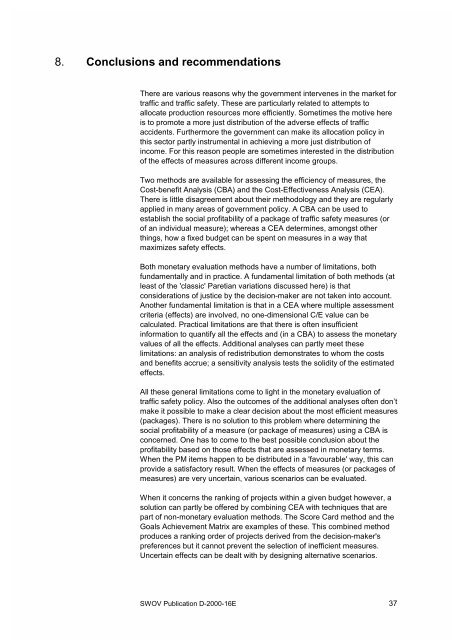Economic evaluation of road safety measures - Swov
Economic evaluation of road safety measures - Swov
Economic evaluation of road safety measures - Swov
You also want an ePaper? Increase the reach of your titles
YUMPU automatically turns print PDFs into web optimized ePapers that Google loves.
8. Conclusions and recommendations<br />
There are various reasons why the government intervenes in the market for<br />
traffic and traffic <strong>safety</strong>. These are particularly related to attempts to<br />
allocate production resources more efficiently. Sometimes the motive here<br />
is to promote a more just distribution <strong>of</strong> the adverse effects <strong>of</strong> traffic<br />
accidents. Furthermore the government can make its allocation policy in<br />
this sector partly instrumental in achieving a more just distribution <strong>of</strong><br />
income. For this reason people are sometimes interested in the distribution<br />
<strong>of</strong> the effects <strong>of</strong> <strong>measures</strong> across different income groups.<br />
Two methods are available for assessing the efficiency <strong>of</strong> <strong>measures</strong>, the<br />
Cost-benefit Analysis (CBA) and the Cost-Effectiveness Analysis (CEA).<br />
There is little disagreement about their methodology and they are regularly<br />
applied in many areas <strong>of</strong> government policy. A CBA can be used to<br />
establish the social pr<strong>of</strong>itability <strong>of</strong> a package <strong>of</strong> traffic <strong>safety</strong> <strong>measures</strong> (or<br />
<strong>of</strong> an individual measure); whereas a CEA determines, amongst other<br />
things, how a fixed budget can be spent on <strong>measures</strong> in a way that<br />
maximizes <strong>safety</strong> effects.<br />
Both monetary <strong>evaluation</strong> methods have a number <strong>of</strong> limitations, both<br />
fundamentally and in practice. A fundamental limitation <strong>of</strong> both methods (at<br />
least <strong>of</strong> the 'classic' Paretian variations discussed here) is that<br />
considerations <strong>of</strong> justice by the decision-maker are not taken into account.<br />
Another fundamental limitation is that in a CEA where multiple assessment<br />
criteria (effects) are involved, no one-dimensional C/E value can be<br />
calculated. Practical limitations are that there is <strong>of</strong>ten insufficient<br />
information to quantify all the effects and (in a CBA) to assess the monetary<br />
values <strong>of</strong> all the effects. Additional analyses can partly meet these<br />
limitations: an analysis <strong>of</strong> redistribution demonstrates to whom the costs<br />
and benefits accrue; a sensitivity analysis tests the solidity <strong>of</strong> the estimated<br />
effects.<br />
All these general limitations come to light in the monetary <strong>evaluation</strong> <strong>of</strong><br />
traffic <strong>safety</strong> policy. Also the outcomes <strong>of</strong> the additional analyses <strong>of</strong>ten don’t<br />
make it possible to make a clear decision about the most efficient <strong>measures</strong><br />
(packages). There is no solution to this problem where determining the<br />
social pr<strong>of</strong>itability <strong>of</strong> a measure (or package <strong>of</strong> <strong>measures</strong>) using a CBA is<br />
concerned. One has to come to the best possible conclusion about the<br />
pr<strong>of</strong>itability based on those effects that are assessed in monetary terms.<br />
When the PM items happen to be distributed in a 'favourable' way, this can<br />
provide a satisfactory result. When the effects <strong>of</strong> <strong>measures</strong> (or packages <strong>of</strong><br />
<strong>measures</strong>) are very uncertain, various scenarios can be evaluated.<br />
When it concerns the ranking <strong>of</strong> projects within a given budget however, a<br />
solution can partly be <strong>of</strong>fered by combining CEA with techniques that are<br />
part <strong>of</strong> non-monetary <strong>evaluation</strong> methods. The Score Card method and the<br />
Goals Achievement Matrix are examples <strong>of</strong> these. This combined method<br />
produces a ranking order <strong>of</strong> projects derived from the decision-maker's<br />
preferences but it cannot prevent the selection <strong>of</strong> inefficient <strong>measures</strong>.<br />
Uncertain effects can be dealt with by designing alternative scenarios.<br />
SWOV Publication D-2000-16E 37
















